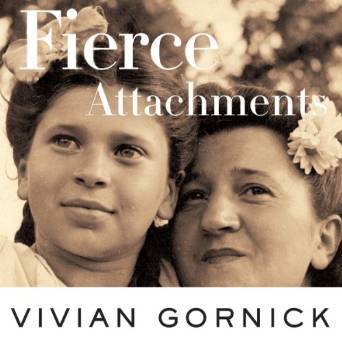Honesty in memoir, ver. 4.0

[Vivian as a girl with her Ma.]
What’s the difference, in reading experience, between fiction and nonfiction? Between reading a novel and reading a memoir?I thought about this during the past week as I reread one of my all-time favorite memoirs, Fierce Attachments. In it, Vivian Gornick braids her story, alternating between the writer’s childhood past, her adult relationship with her mother as they talk or walk around New York, and continuing into her adult experience with men. Gornick both discusses and dramatizes these realms. She is a master of the reflective persona and also of bringing her experience to life in scene.
I’d read the book three or four times before. But this time I had just slogged through a traditional chronological plotted novel, a traditional plotted and chronological memoir that verged on autobiography, and was trying to read another traditional plotted novel. These books, in stark contrast to Gornick’s, were heavy going. Her thinking and writing—at the sentence and structural level—excited me as before.
But would I be loving Fierce Attachments if it were fiction? If it had been written and sold as a novel? How much does my enjoyment owe to its labeling as nonfiction?
Let’s get something out of the way. Gornick once mentioned to a roomful of journalists that she invented in Fierce Attachments a street encounter she and her mother experienced. The reporters were soon baying at her, and the flap spread online. I can’t endorse what she did, but it hasn’t bothered me as her reader because her goal seems only to fully and honestly portray herself and mother. She might have handled her imagination differently, such as cued the reader, but instead she embroidered.
Still, try to read Fierce Attachments as a novel. Would I find it as absorbing? I kept asking
Some fiction asks me to suspend too much disbelief
Living beside a college with an impressive drama program, I watch many plays. Gradually it dawned that much fiction is driven by portraying conflicts that actually never happen in most lives. I mean family fights or blowups with friends in which longstanding resentments are aired, lanced, and resolved. I know, it’s drama. The theatre could scarcely exist without this convention.
Of course people do disagree and even fight, sure. They yell and sometimes throw things, I understand. But more often, people sublimate or seethe. Aren’t fights, when they happen, quick, a few words? Often harsh only in retrospect? And then years follow when nothing is fixed. But neither is anything fatally broken—as in a verbal brawl. The truth is, we’re a civilized species, with key defaults of repression and depression. We swallow pain to avoid worse pain.
You wouldn’t know this from many plays, movies, short stories, and novels. I imagine that this conflict flows from the fictionist’s inciting question, What if? Maybe s/he broods upon buried feelings to turn a human wish for healing into literary art. The result is what might happen if people would do what in fact they wisely avoid: use rage in pursuit of transcendence.
But people do rage in Gornick’s memoir!
![[Vivian Gornick.]](https://i.gr-assets.com/images/S/compressed.photo.goodreads.com/hostedimages/1452798986i/17745439.jpg)
[Vivian Gornick.]
Boy, is this an irony. Gornick and her mother are stereotypes of an immigrant Jewish or perhaps Yiddish culture in which people pick at each other. At least her mother does. In response, mother and daughter often shout and even scream. As a repressed WASP, I envy the emotional venting. But not the obvious pain and insecurity the constant criticism creates. Oy vey!All the same, the ferocity in Fierce Attachments is different from fiction’s. It’s more intimate, more real. It’s less clear what it’s about, and the outcome is much less healing.
Most fiction isn’t Anna Karenina. It’s some guy wondering, What would’ve happened if Mama had poured a bottle of wine over Daddy’s head? I’m generalizing about fiction here. And not bashing it—my top ten books list might include eight novels. But as emotionally extreme as Gornick’s upbringing apparently was, her world is subtle compared with popular fiction’s.
I decided, quite reluctantly, that much of the appeal of Fierce Attachments is due to it being nonfiction. It probably wouldn’t be exciting enough as a novel, except maybe in the most rarified literary form. But as a memoir depicting the forces and especially the mother that forged the writer? Wow.
Memoir’s peculiar appeal
Hewing as much as possible to nonfiction’s promise to be nonfiction is important because that promise embodies a crucial aspect of nonfiction’s appeal. Someone like you or me is working hard to understand and convey her life. Since some of us are walking around doing that in our heads, it’s compelling to read someone’s shaped but real and real-time account of this task.
Memoir isn’t allowed to be boring just because “it happened.” And it won’t be, however quiet its surface events, if it is fulfilling its role as an instrument of inquiry and understanding. Those virtues also remove the taint of voyeurism in memoirs that depict trauma and severe dysfunction.
Memoir’s peculiar appeal lies not in its label of truth but the effort we sense someone making to arrive at deeply personal truth and honest self-portrayal. That’s the honesty in memoir—subjective truth and unsparing self-portrayal. I have thrown down a memoir in disgust for their lack. I honor Gornick’s for their presence.
Take my 2016 memoir challenge. Take your favorite memoir and try to read it as fiction. Very instructive.
The post Honesty in memoir, ver. 4.0 appeared first on Richard Gilbert.



